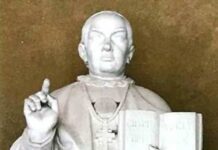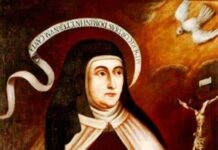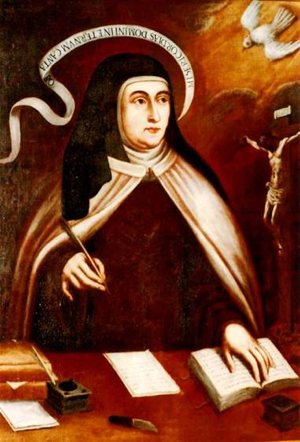St. Teresa of Jesus was born in Avila, Spain, on March 28, 1515, one of twelve children in a faith-filled home. At age seven she read the lives of the saints and was so inspired by the martyrs that she and her brother Rodrigo began walking south toward the Moors hoping to gain instant access to heaven. They were intercepted on their way by their uncle and returned home.
Young Teresa’s religious fervor cooled during her adolescence. She read racy novels, became preoccupied with her appearance, and used perfume. She later admitted that she was more interested in boys than religion.

Her spiritual life got back on course when she read the letters of St. Jerome and shortly thereafter experienced the call to be a religious sister. She entered the Carmelite Convent of the Incarnation in Avila in 1535 and made her first profession of vows in 1537. The next year she came down with a serious illness that persisted for two years followed by partial paralysis for another. The doctors had given up on her. She turned to prayer and recovered.
The convent in Avila was affluent and the nuns enjoyed a comfortable lifestyle. It was close to town, the sisters received many guests, and they were caught up in the ways of the world. St. Teresa was a good nun during her initial years in the convent, but when she was older, she described the period as spiritually mediocre.
She went through a dramatic conversion which began in 1554. She prayed before a crucifix and later wrote, “When I looked at Christ hanging poor and naked on the Cross, I felt I could never bear to be rich.” The next year she read the Confessions of St. Augustine and resolved to dedicate the rest of her life to prayer. The same year her mystical experiences began. There were divine revelations from God. She received visions from St. Mary Magdalene and St. Augustine, both who showed her the miserable place in hell that was reserved for her. She had other moments of rapture and ecstasy. The mystical experiences went for six years until 1560.
Fearing hell for herself, she set out to save her soul, as well as the souls of her fellow Carmelites. She returned to the full observance of the Carmelite rule, a strict cloister, more prayer and contemplation, penitential practices, and rigorous austerity. There were 140 nuns in the convent. Many doubted her visions and ridiculed her. Most were content with their pleasant life and bitterly opposed her reform movement. It caused a deep rift and two divergent branches emerged within the community, the non-reformed, relaxed, or Calced Carmelites, those with shoes, and the “the Strict Observance,” the Discalced Carmelites, those without shoes.
St. Teresa founded a new convent in 1562. Thirteen other nuns joined her. She founded sixteen other convents from 1562 to 1576. In 1568 she helped St. John of the Cross found a community of Discalced Carmelites for men. She wrote three spiritual masterpieces: The Life her autobiography and a treatise on mystical prayer, The Way of Perfection on mystical theology, and The Interior Castle, a metaphorical description of the seven stages of spiritual growth.
St. Teresa died on October 4, 1582 in Alba de Tormes, Spain, at the age of 67. She was canonized a saint in 1622 and declared a Doctor of the Church by Pope Paul VI in 1970. She is the patron saint of Spain and Croatia and headache sufferers. Her symbols are a book and a quill pen because of her writings and a flaming arrow in a heart because she said, “God’s love is like a lance driven into the heart.”


















